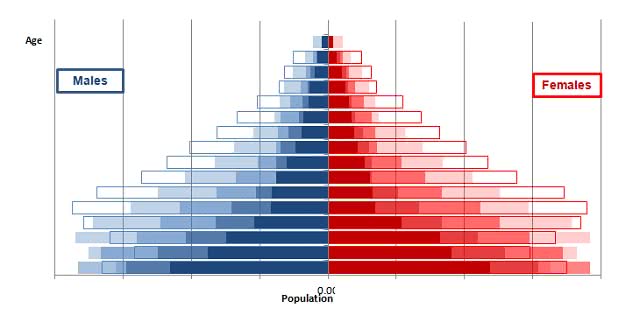The Population pyramids are the true graphical representation of a population’s age and sex. These graphs are more likely shaped as triangles and hence the pyramids. The pyramid has males on its left and females on its right side and a vertical line separating the males and the females. It is very obvious for the graphical representation to differ both as a region and time changes. But they still can be classified into three common categories. They are Stationary Pyramid, Constrictive Pyramid, and Expansive Pyramid and is discussed briefly below. Demographers can derive vital information about the birth rate & death rate of a country. The shape of any population pyramid is a indication of what challenges or advantages a particular place or region will face.

Related: Various Population Projection Methods | Types & Importance
Three types of Population Pyramids – Stationary (Stable), Constrictive & Expansive
1. Stationary pyramid: A stationary pyramid or stable pyramid is created if the rate of birth and death remains the same in a population over time. This is usually a rectangular or square shaped graphical representation where it is slightly tapering at the top of the graph. This is very usual since deaths occurring among the elderly is more. Countries with better living conditions, geriatric care, and medical facilities have a high expectancy of life. Also, many countries have a stable rate of birth as they have more awareness to use the birth control measures. Such type of pyramid shows a stable increase along with the population in due time. It can also be regarded as a population pyramid which is showing an unchanging pattern of fertility & mortality.
The stationary pyramid is mostly seen for the highly developed countries like Sweden, the USA, and the Netherlands. They have very well economics established in them.
2. Constrictive Pyramid: A population that has a low or a declining number of younger people when represented in a bar diagram gives a constricted pyramid. This is a result of a country having a slow or declining birth rate with each succeeding age group getting smaller and smaller. The country will have more older people than younger ones.
The large number of older people can also be linked to good health care facilities for older citizens. This reduces the death rate in high age group and they live longer.
3. Expansive Pyramid: Expansive pyramids represent a population that has a large percentage of young people. With a wide base expansive pyramid usually depicts a population with a high fertility rate and lower life expectancies. The number of people in the older age group is usually low and thus has a narrow top. Many developing countries have expansive population pyramids.
This type of shape highlights that a country has a large population which is in working age and requires a large number of jobs.
The steady narrow in the top shows that people die at each of the high band. This type of pyramid usually shows:
- The country has a high birth rate
- Also, high death rate
- Expectancy of short life
- Economically a developed country
What is the use of population pyramid?
With the population pyramid, it helps to understand the AP Human Geography and the AP Environmental Science. Mostly, the demographers use this population pyramid to understand and examine the trends of population in the past and the profile of the current resident. Also, through this population pyramid, an increase or decrease in the population of the future can be predicted. With this prediction, there can be a forecast of the surrounding flora and fauna.
With the increase and decrease of population comes many external factors of sustainability. If the population of a country is increasing, it is required to ensure that the minimum requirement for better living is provided by the country and od the necessary steps to retain the same.
And in the same way, if for a particular country or region, the population is narrowing down, then it is important to understand the reason and do the needful to save the lives. Hence, the population pyramid plays a vital role in the economics of a country and to retain lives.
World Population Stats & Facts:
- World population is unevenly distributed. Urban areas accounting more than 50% of total population.
- China is known to have one child policy for many years in some places. The reason for such policy has number of reasons one of which was controlling the birth rate & thus over all population increase.
- Less than 10 countries account for more than half of population growth
- Govt. in populous countries provide incentives & benefits in various forms to have small families.
- In few countries govt. is providing incentives to have more children and invites people from other countries to join their workforce.
Demographic Transition Model (DTM)
DTM helps in identifying different period of development related to population characteristics. It is based on variations in crude birth rates & crude death rates. As per demographic transition model there are five phases:
- Phase 1 – High Births, high deaths
- Phase 2 – High Birth, declining deaths
- Phase 3 – Declining births, Low Deaths
- Phase 4 – Low Births & Low Deaths
- Phase 5 – Deaths higher than births
Tags: Types of Population, Population Pyramid Type, Expansive Pyramid, Stationary Population Pyramid, Population Pyramid Types, Constrictive Population Pyramid, population pyramid types, stable pyramid, stationary pyramid, constrictive pyramid, expansive pyramid.